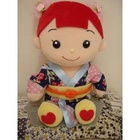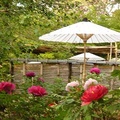今年のブラジルの夏は、70年ぶりの猛暑となり、とても大変でした。街を歩いていると、皆、真っ赤な顔をして、汗をかきながら、動きが鈍くなってへとへとでした。そんな中、昔から暑さが苦手な私ですが、今年は比較的楽に厳しい日々を乗りきることができました。その理由は、私が日本の夏の過ごし方をブラジルで実践したからです。夏になるとブラジルと日本の生活習慣の違いを実感せざるを得ません。
42年前に私は日本に留学しました。一人娘を旅に出した両親は「日本の冬の寒さ」を心配していましたが、私はなんとか無事に寒い冬を越すことができました。そして、初めての日本の夏がやって来ました。今振り返ってみると、あの夏は今でも印象深く心に残っており、大切なことをたくさん学んだ季節でもありました。
当時、サンパウロの気温は今のように高くなかったので、日本の夏はとても暑苦しいと感じました。お世話になっていた下宿のおばさんや友だちは「スタミナをつけるように」と、いろいろな食べ物を紹介してくれました。初めて口にするものばかりでした。枝豆、トマトジュース、カレーライス、やきとり、うな丼。そして、枝豆と合うのがカルピスでした。どれも美味しくいただきました。ところてんも初めて食べて好きになりました。
実は、ブラジルには暑さで食欲がなくなるからと言って、食べ物を工夫する習慣がありません。夏はジュースや軽食で済ませるのが一般的です。ですから、私は日本人が食べ物で暑さを乗り切ろうとすることに最初は驚きを感じましたが、すぐにそれは、とても重要なことだと気が付きました。それ以来、夏には勢力のある食べ物を取るようにと、心がけています。
先日、日本の習慣を身に付けた私に、こんな面白いできごとがありました。朝食をしっかり取ってから、朝早くに家を出ました。朝食の話を同僚にすると、「暑い日によく食べられるわね!」と、びっくりされました。すると、一緒にいた日系人の女性は「ジャポネスと同じよね」と。日系人の多くは、日本人は皆、朝からごはんとみそ汁をしっかり食べると思い込んでいるのです。
またある日、「カレー食べに来ない?」と、友人を誘うと「えっ!?カレーって冬に食べるんじゃない?」と。「そんなことないのよ。日本で初めて食べたカレーは、真夏だったし、カレーは食欲をそそるのよ」と言いたかったが、結局、私はその日のメニューを変えてしまいました。
またこれも、42年前の日本滞在中に学んだことです。下宿のおばさんが「はらまき」について教えてくれました。初めて「はらまき」というものを知りましたが、夏でも、冷えを防ぐためには良いとのこと。ブラジルに戻ったとき、夏になるといつも扇風機の真正面に座って涼んでいる父に、さっそく腹巻きの効能について教えました。残念ながら、暑がりの父は、「もっと暑くなる」といって見向きもしませんでしたが。
日本で初めて海水浴に行った時も驚きました。子どもも大人も水着の上に必ずTシャツか薄での上着を着て、帽子やパラソルも用意してたからです。それを見たとき、母が言っていたことを思い出しました「色の白いは七難隠す」。なるほど!今からでも遅くないから、そうしよう!と、私はブラジルに帰ってからも日焼け対策を心がけるようになりました。
ある年の夏休みにブラジルの有名な観光地に行きました。土産物店に入ると、店員の女性が私を見て「お客さん、暑いでしょう?その上着を脱いだら?」と。見ず知らずの人に言われて戸惑っていると、彼女は笑顔で「ここは太陽の国よ。日焼けしないと損しますよ」と、またまた文化の違いに気づかされました。
毎年、夏になると、私は日本のソーイングブックを手に、好きな服を作るのを楽しんでいます。ゆったりしたエプロンワンピースかジャンパスカートか。ブラジルでは絶対に流行らない服ばかりですが、夏を快適に涼しく過ごすにはかかせないアイテムだと思います。
コットン100%のエプロンワンピースを着て、帽子かパラソルを持って出かけると、どんなに暑い日でもさわやかな気分になれます。
ただ、ブラジルでは、ほとんどの女性は細めのパンツを着るのが普通で、ぶかぶかの長めのワンピースはまれです。私が40代の頃、お気に入りのワンピースで買い物をしていたら、後から小さな子どもが母親に「あの人誰?」と聞くと、「どっかのおばあちゃんでしょ」と言う声が聞こえました。ショックでしたが、無理もないと思いました。
私と二度目に会った日系人の女性が「覚えているわ。初めてお会いした時、あなたは白いお帽子をかぶっていたわね」と。真昼の太陽の下で紫外線防止加工のパラソルを差して集会に参加していた時、「あなた、パラソルいつも差しているの?」と、周りの女性たちに聞かれました。
私は満足しています。日本での体験と日本の雑誌やNHKの番組からの情報はとても便利で、私のライフスタイルに大変役立っています。
今年はもう間に合わないけれど、来年の夏は家のベランダに立派なグリーンカーテンを育てようと、今から計画しています。この街でたった1つのグリーンカーテンになるかも知れません。
© 2014 Laura Honda-Hasegawa





